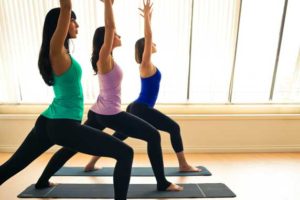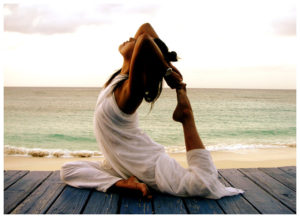Amy Levin: For most of us, it’s hard to wrap our heads around yoga – yes, this thing everyone is talking about, but also the details about how it got here, where it came from, and what the big deal is. Yoga has become such a part of our vernacular, and yet we seem to stumble over describing it.
If someone asked you, what is yoga? You might answer something like, “An exercise regimen,” or even, “Oh, it’s an ancient Indian practice that involves body poses and stretching while concentrating on your breath.” Accurate? Sure, in a watered-down kind of way. But while there are those who scowl at the $30-a-session, lululemon-dress-code yoga studios on every block of gentrified Brooklyn (for their lack of “authenticity,” for their smug ubiquity?) others are extending the yoga conversation to an entirely new platform, and its on the ever-so-sexy-liberal-feminist project: women’s empowerment.
In Meera Subramanian’s recent piece on Religion Dispatches, “What’s in an Om? How Women are Transforming Yoga,” we get a good slice of how yoga has become part of the global empowerment discourse, as evidenced by a new documentary called “Yogawoman”:
Made by Australian filmmaker Kate Clere McIntyre, in collaboration with her husband Michael McIntyre and sister Saraswati Clere, the film is a love letter to yoga—for urban women in lululemon pants, yes, but also for women fighting cancer and women who are large, for girls locked up in juvie and kids in a Nairobi slum, for women trying to find a lost libido and women about to give birth. More than fifty women and girls cross the screen in an hour and half. Their bodies are flowing through vinyasas in packed classes, teaching and being taught. Their heads are talking, telling us their conversion stories. Seane Corn of Off the Mat recalls her ah-ha moment at 23, as she walked down the street one day at a time in her life when nothing was going particularly well. Yet she was happy. “Could it be the yoga?” she marveled.
Conversion? Testimonials? A-ha moments? African slums? The fact that these seemingly divergent realities make cultural sense begs me to turn to the arbiter of all feminine commodities: Oprah. And you don’t have to ask twice if Oprah loves yoga (watch Jennifer Aniston present a yogalicious birthday gift to her). It seems that both Oprah, as celebrity and brand, and “Yogawoman,” are in a symbiotic relationship with yoga–women are transforming yoga, so that yoga can transform them.
Not to be a doggie downer, but the more media outlets and Barnes & Noble bookshelves are flooded with change-your-life yoga books, we can’t help but be nauseated. Flip through the plethora of yoga magazines and you’ll find yoga for better health, better sex, better backs, better balance, better menopause, better self-esteem, weight loss, naked yoga, pet yoga, Christian yoga, alphabet yoga, facial yoga, laughing yoga and, yes, yoga on a bike. Ick. Is this nausea a symptom of our age of authenticity, the search for origins, since apparently postmodernism is dead, or is there something more ethically potent that unrests us?
To play the game of authenticity, here’s some handy info: the word yoga comes from the word yuj in Sanskrit which means to yoke or to bind. However, a common interpretation for the word is “union,” as it is associated with the union of body and mind. The Yoga Sutra, compiled by Patanjali in the second century, is known as the oldest description of the philosophical basis for yoga, and part of the overall six schools of South Asian philosophy. Feel better? Probably not, because origins only signal a small part of authenticity, and our modern forms of yoga don’t look very “original.” Even if we look to India to find yogic authenticity, it was in its “homeland” that yoga was first modernized. Yoga scholar Joseph Alter claims, “As early as 1930, Swami Kuvalayananda was ‘mass producing’ yoga instructors.”
We can trace the cultural appropriation of yoga in the West to Swami Vivekenanda, who, as scholar Richard King notes, “placed particular emphasis upon the spirituality of Indian culture as a curative for the nihilism and materialism of modern Western culture.” Whether or not you believe in a secularization narrative that wiped out religion in the modern world, we can least agree that in this culture, religion = bad, spirituality = good. And spirituality sells.
Not only does spirituality sell, but a particular type is quite marketable – the kind that makes women feel good. Turning back to the queen of consumption, Oprah might have something to tell us, via Kathryn Lofton’s Oprah: The Gospel of an Icon. Lofton tells us how Oprah is (or was, now that she’s been raptured) much more than talk show host – in fact, she shows us how to live our “best life,” a.k.a., buying stuff to make us feel good. In fancy terms, that means spiritual capitalism – a method of buying that simultaneously (and conveniently) helps others, or at least our own path to feminist enlightenment. Lofton tells us that Oprah’s main mantra is self-realization through consuming – “Every day the path to your own spirituality starts with clarifying who you are and what you want.” She has particular beliefs as well. “We believe in meditating,” Winfrey related during her 2001 Live Your Best Life Tour. “I believe in meditating in the tub with some very nice bath products.”
And here comes the ick again. It’s the same affective reaction that UCC Pastor Lillian Daniel feels when she encounters those “spiritual but not religious” types. Though Kate Blanchard at Religion Dispatches gives these hopeful “God is in the sunset” people a break, I have to side with Pastor Daniel – and it’s more than nausea. It’s a woman thing, and its a commodity thing. Oprah’s meditative bath products may sound miles away from the “yogawomen” in prison, Brooklyn, or Nairobi, but they have something in common – something female, something empowering, something “O.” My worry, is that when you add enough O’s together, you end up with zero. So while the Om may lead women to fulfill a profound spiritual enlightenment, empowerment, or just a sense of tranquility, I can’t help but think of what we are emptying – not just our wallets, but our minds, our sense of creativity, and a settling for easy answers instead of grappling with those age-old “meaning of life” questions that lead us towards moments of social and individual effervesence.



